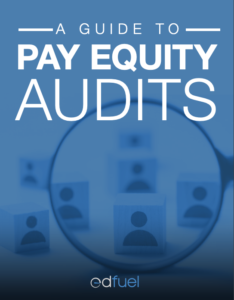A Guide to Pay Equity Audits
Compensation inequity is unfortunately nothing new. In fact, you’d be hard pressed to find a time period in the United States when people from all races, genders, and backgrounds earned equal pay for equal work. As talent leaders in mission-driven school systems and nonprofits, it is critical for us to take active steps to identify the ways in which our current compensation programs are either advancing or detracting from equitable financial recognition of our employees. With this in mind, we’re pleased to share the EdFuel Pay Equity Audit Guide, a new open-source resource to help you assess the level of compensation equity within your organization.
Why you should do this work
Many of us are aware, at least tangentially, of the pervasive compensation inequities within the United States. As of 2019, women made 85 cents on the dollar compared to men (Pew, 2019).

And since the year 2000, wages have grown about four times faster for White and Hispanic workers than for Black workers (Economic Policy Institute, 2019). What does this mean in real terms? Well, imagine that you hired three workers - a White Male, a Hispanic Female, and Black Female - in the year 2000 for the same job, with a target starting salary of $50,000. Assuming regular raises, by the year 2020, the White Male would have earned about $1.3 million in total salary, about $200,000 more than the Hispanic Female and $350,000 more than the Black Female. That gap is astounding - it is the cost of a new house, a graduate degree (or two), or a safeguard against personal bankruptcy in the case of an expected medical emergency.
While we all recognize how pernicious compensation inequities can be, determining if they exist within our own organizations can be challenging. Most employees only know their own salaries, or perhaps the salaries of a few close colleagues. And staff who do have access to comprehensive compensation data (Finance and HR Directors, school leaders, CEOs/CFOs, etc) may not be sure how to most effectively analyze salaries across job profiles, locations, and other demographics.
Of course we all hope that compensation inequities do not exist at our organization, but given our country’s history of pervasive compensation inequality, it is essential that talent/HR leaders (those staff who are entrusted to manage compensation data) take active steps to understand what is really going on within the systems they oversee.
What this guide will (and will not) help you do
The EdFuel Pay Equity Audit Guide offers a step-by-step process (with examples) to analyze compensation practices and equity trends within your own organization. Put simply, it is a starting place to examine whether race, gender, and other demographic factors that shouldn’t be related to compensation are systematically influencing how people from certain backgrounds are paid. 
This guide will not be that helpful in analyzing compensation for individuals. It will not tell you how much each employee “should” make, or whether each person’s salary is “fair” given their function, experience, skill set, performance, or other factors. What it will help you do is identify, at scale, any differences in compensation that may be attributable to race, gender, or other aspects of identity that are meaningful to you and your colleagues.
Given this org-wide lens, here are a few types of questions you might explore with this guide:
Gender
Are there differences in pay that exist along lines of gender? Along lines of race?
Teams
How competitive (compared to market benchmarks) is compensation for Analysts compared to Directors? Is the Operations team over or under paid relative to the Program team?
Experience
How competitive is compensation for your executive team compared to your entry-level employees?
Talent Practices
Are certain talent practices (eg. hiring policies) indirectly contributing to differences in compensation by race and gender? For example, is your policy for rewarding “advanced degrees” financially advantageous to employees from certain backgrounds?
What you’ll need to do this work well
There are a few things that you’ll need in order for this work to be as effective as possible:
- First, you’ll need access to clean and complete compensation data. This includes salary, raise, and bonus (if applicable) data, as well as employee demographic information.
- Most likely, you’ll also need access to market benchmarks for each position you want to analyze. Being able to compare each employee’s compensation to their own market benchmark allows you to create “apples to apples” analysis when looking at trends across roles, departments, or demographic groups. EdFuel provides support on market benchmarking if you find yourself in need of additional data for any or all of your employee groups.
- Finally, you (or someone on your team) will need at least a basic understanding of data management and analysis. You don’t necessarily need to be an “Excel wizard”, but you’ll need to know how to organize data in a spreadsheet and perform basic calculations using formulas.
Don’t be intimidated if you don’t have “perfect” data or this is your first time doing this kind of analysis - just going through the steps outlined in the guide may highlight changes to how you collect and track employee data that are beneficial to your organization as a whole.
Where you go after this
At the root of almost all compensation inequities is implicit bias. Given this, you will likely need to consider how your various talent systems may be jointly contributing to inequities, and how implicit bias may be influencing the individuals (leaders and managers) responsible for designing and maintaining these systems.
Implicit bias can show up in compensation in a variety of ways. Inequitable promotion policies or representation of certain demographic groups (often White) among leadership can impact org-wide trends. Performance-pay systems, while almost always well-intentioned, are notorious sources for inequitable outcomes when it comes to employee retention, promotion, and compensation. Higher attrition for employees from certain demographic groups can compound compensation gaps compared to the types of employees more likely to stay, and biases in your hiring process can lead people from certain demographic groups to receive lower starting salaries. Of course, your organizational context and history will shape where and how you focus your inquiry.
Ultimately, identifying a compensation inequity is just the first step; knowing how to fix that inequity is a wholly different challenge. Some organizations choose to be open with their employees about the inequity and take immediate steps to address it, usually in the form of equity-based compensation adjustments. Other organizations choose to implement new organizational policies that will promote increased equity over time. Every approach has pros and cons that should be carefully thought through, including potential legal implications or liability concerns.
As always, feel free to reach out to us with specific questions, or to discuss how EdFuel can support you get started with this type of analysis.
